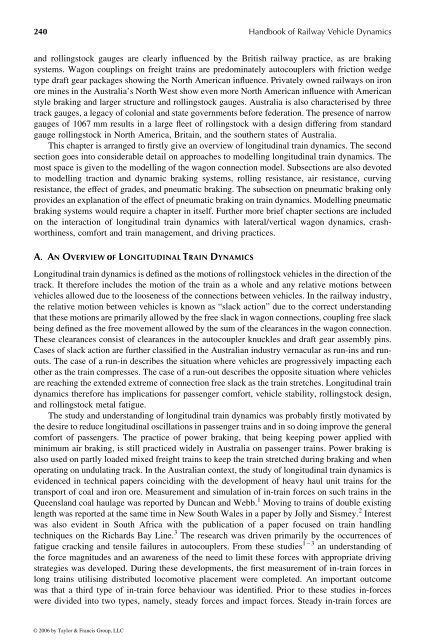Hi-Res PDF - CRCnetBASE
Hi-Res PDF - CRCnetBASE
Hi-Res PDF - CRCnetBASE
Create successful ePaper yourself
Turn your PDF publications into a flip-book with our unique Google optimized e-Paper software.
240<br />
and rollingstock gauges are clearly influenced by the British railway practice, as are braking<br />
systems. Wagon couplings on freight trains are predominately autocouplers with friction wedge<br />
type draft gear packages showing the North American influence. Privately owned railways on iron<br />
ore mines in the Australia’s North West show even moreNorth American influence with American<br />
style braking and larger structure and rollingstock gauges. Australia is also characterised bythree<br />
track gauges,alegacy of colonial and state governments before federation. The presence of narrow<br />
gauges of 1067 mm results in alarge fleet of rollingstock with adesign differing from standard<br />
gauge rollingstock in North America, Britain, and the southern states of Australia.<br />
This chapter is arranged to firstly give an overview of longitudinal train dynamics. The second<br />
section goes into considerable detail on approaches tomodelling longitudinal train dynamics. The<br />
mostspace is giventothe modellingofthe wagon connection model. Subsections are also devoted<br />
to modelling traction and dynamic braking systems, rolling resistance, air resistance, curving<br />
resistance, the effect of grades, and pneumatic braking. The subsection on pneumatic braking only<br />
provides an explanationofthe effect of pneumatic braking on train dynamics. Modelling pneumatic<br />
braking systems would require achapter in itself. Further more brief chapter sections are included<br />
on the interaction of longitudinal train dynamics with lateral/vertical wagon dynamics, crashworthiness,<br />
comfort and train management, and driving practices.<br />
A . A N O VERVIEW o F L ONGITUDINAL T RAIN D YNAMICS<br />
Handbook of Railway Vehicle Dynamics<br />
Longitudinal train dynamicsisdefined as the motions of rollingstock vehicles in the direction of the<br />
track. It therefore includes the motion ofthe train as awhole and any relative motions between<br />
vehicles allowed due to the loosenessofthe connections between vehicles. In the railway industry,<br />
the relative motion between vehicles is known as“slack action” due to the correct understanding<br />
that thesemotions are primarily allowed by the free slack in wagon connections, coupling freeslack<br />
beingdefined as the free movement allowed by the sum of the clearances in the wagon connection.<br />
These clearances consist of clearances in the autocoupler knuckles and draft gear assembly pins.<br />
Cases of slack action are further classified in the Australian industry vernacular as run-ins and runouts.<br />
The case of arun-in describes the situation where vehicles are progressively impacting each<br />
otherasthe train compresses. The case of arun-out describes the opposite situation where vehicles<br />
are reaching the extended extremeofconnection free slack as the train stretches.Longitudinal train<br />
dynamics therefore has implications for passenger comfort, vehicle stability, rollingstock design,<br />
and rollingstock metal fatigue.<br />
The study and understanding of longitudinal train dynamics was probably firstly motivated by<br />
the desire to reducelongitudinal oscillationsinpassenger trains and in so doing improve the general<br />
comfort of passengers. The practice of power braking, that being keeping power applied with<br />
minimum air braking, is still practiced widely in Australia on passenger trains. Power braking is<br />
also used on partly loaded mixed freight trains to keep the train stretched during braking and when<br />
operating on undulating track. In the Australian context,the studyoflongitudinal train dynamics is<br />
evidenced in technical papers coinciding with the development of heavy haul unit trains for the<br />
transport ofcoal and iron ore. Measurement and simulation of in-train forces on such trains in the<br />
Queensland coal haulage was reported by Duncan and Webb. 1 Moving to trains of double existing<br />
length was reported at the same time in New South Wales in apaper by Jolly and Sismey. 2 Interest<br />
was also evident in South Africa with the publication of apaper focused on train handling<br />
techniques on the Richards Bay Line. 3 The research was driven primarily by the occurrences of<br />
fatigue cracking and tensile failures in autocouplers. From these studies 1–3 an understanding of<br />
the force magnitudes and an awareness of the need to limit these forces with appropriate driving<br />
strategies was developed. During these developments, the first measurement of in-train forces in<br />
long trains utilising distributed locomotive placement were completed. An important outcome<br />
was that athird type of in-train force behaviour was identified. Prior to these studies in-forces<br />
were divided into two types, namely, steady forces and impact forces. Steady in-train forces are<br />
© 2006 by Taylor & Francis Group, LLC









